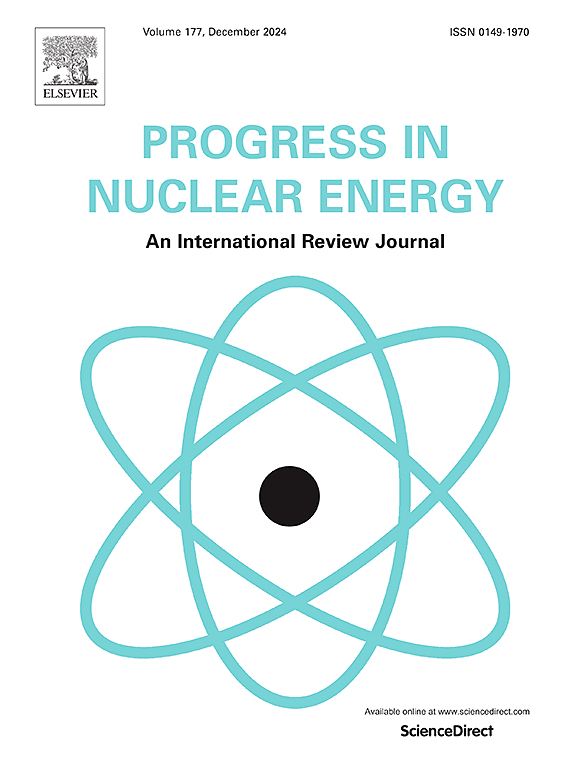CFD simulation of internal center flow blockage in helical-cruciform fuel assembly
IF 3.3
3区 工程技术
Q1 NUCLEAR SCIENCE & TECHNOLOGY
引用次数: 0
Abstract
Helical-cruciform fuel (HCF) rod, an innovative fuel design, has been proposed for its promising thermal-hydraulic performances, which is characterized by contacting at points between rods to achieve self-supporting without space grids. Blockages are most likely to occur at contact point zone for the deteriorated fluidity and a flow blockage accident is caused. Hence, flow characterization of coolant flow in 7 rods HCF assembly with internal center blockage has been carried out by Reynolds-Averaged Navier-Stokes (RANS) based CFD simulation. In this paper, influence of different minimum gap values between petals have been evaluated. Based on this, different turbulence models have been validated for the law of the wall, after which CFD results of axial velocity profiles in the interior and exterior channel have been compared against in-house hydraulic experimental data of 7 HCF rod bundle. Focus has been paid to analyzing hydraulic features in HCF assembly with various blockage configurations, including different thicknesses and blocked percentage of flow channel sectional area. It is observed that special vortex structure formed upstream and downstream in typical blockage conditions. The transverse flow upstream and downstream of blockages is enhanced with increasing blockage thickness and blocked area. The results of the present study would serve as foundation for further in-depth flow blockage incidents analyses in HCF rod assembly.
螺旋-十字形燃料组件内部中心流动阻塞的CFD模拟
螺旋十字形燃料棒(HCF)是一种新型的燃料设计,其特点是在棒之间的点接触,实现无空间网格的自支撑,具有良好的热水力性能。接触点区域流动性变差,最容易发生堵塞,造成堵塞事故。因此,采用基于reynolds - average Navier-Stokes (RANS)的CFD模拟方法,对含中心内堵塞的7棒HCF组件进行了冷却剂流动特性分析。本文对不同花瓣间最小间隙值的影响进行了评价。在此基础上,对不同湍流模型的壁面规律进行了验证,并将CFD计算结果与7 HCF杆束内部水力实验数据进行了对比。重点分析了不同堵塞配置下HCF组件的水力特征,包括不同厚度和流道截面积堵塞百分比。观察到在典型阻塞条件下,上游和下游形成了特殊的涡结构。随着堵塞厚度和堵塞面积的增加,堵塞上下游横向流动增强。本研究的结果将为进一步深入分析HCF棒组中的流动堵塞事件奠定基础。
本文章由计算机程序翻译,如有差异,请以英文原文为准。
求助全文
约1分钟内获得全文
求助全文
来源期刊

Progress in Nuclear Energy
工程技术-核科学技术
CiteScore
5.30
自引率
14.80%
发文量
331
审稿时长
3.5 months
期刊介绍:
Progress in Nuclear Energy is an international review journal covering all aspects of nuclear science and engineering. In keeping with the maturity of nuclear power, articles on safety, siting and environmental problems are encouraged, as are those associated with economics and fuel management. However, basic physics and engineering will remain an important aspect of the editorial policy. Articles published are either of a review nature or present new material in more depth. They are aimed at researchers and technically-oriented managers working in the nuclear energy field.
Please note the following:
1) PNE seeks high quality research papers which are medium to long in length. Short research papers should be submitted to the journal Annals in Nuclear Energy.
2) PNE reserves the right to reject papers which are based solely on routine application of computer codes used to produce reactor designs or explain existing reactor phenomena. Such papers, although worthy, are best left as laboratory reports whereas Progress in Nuclear Energy seeks papers of originality, which are archival in nature, in the fields of mathematical and experimental nuclear technology, including fission, fusion (blanket physics, radiation damage), safety, materials aspects, economics, etc.
3) Review papers, which may occasionally be invited, are particularly sought by the journal in these fields.
 求助内容:
求助内容: 应助结果提醒方式:
应助结果提醒方式:


